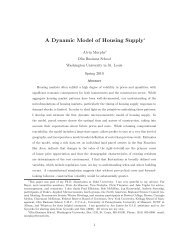Shopping Externalities and Self Fulfilling Unemployment Fluctuations*
Shopping Externalities and Self Fulfilling Unemployment Fluctuations*
Shopping Externalities and Self Fulfilling Unemployment Fluctuations*
You also want an ePaper? Increase the reach of your titles
YUMPU automatically turns print PDFs into web optimized ePapers that Google loves.
a seller meets a buyer is constant. In Benhabib <strong>and</strong> Farmer (1994), Farmer <strong>and</strong> Guo (1994),Christiano <strong>and</strong> Harrison (1999) <strong>and</strong> Mortensen (1999), the strategic complementarity in employmentis caused by a production externality. That is, the higher is aggregate employment,the higher is the output of a worker. In contrast, in our model the production technology isconstant. The models by Heller (1986), Roberts (1987), Cooper <strong>and</strong> John (1988) <strong>and</strong> Gali(1996) are closest to ours. In those models, the strategic complementarity in employmentis caused by a dem<strong>and</strong> externality. That is, the higher is aggregate employment, the higheris the dem<strong>and</strong> faced by an individual seller <strong>and</strong> the higher are its pro…ts. In our model,the strategic complementarity in employment is caused by the shopping externality, whichis given by the sum of the external e¤ect of employment on dem<strong>and</strong> <strong>and</strong> on market power(net of the captivity e¤ect). In our model, the higher is aggregate employment, the higheris an individual seller’s dem<strong>and</strong> <strong>and</strong> the higher is an individual seller’s probability of tradeat a given price. As we will demonstrate in Section 5, it is precisely the combination of thedem<strong>and</strong> externality <strong>and</strong> the market power externality that allows us to generate multiplicityfor a reasonably calibrated version of the model. However, from a theoretical point of view,each externality in isolation is su¢ cient to generate multiplicity.When = 0, the income of employed <strong>and</strong> unemployed buyers is identical <strong>and</strong>, hence,aggregate employment does not generate a dem<strong>and</strong> externality. In this case, the derivativeof S(u) with respect to u is given by (1 +S 0 (u) =u )(1 + e ) 2 e (1 u)b(u) 2 1 + e b(u)2 u (1 u)y u1 + u b(u)eb(u) 1 + e+2 1 + u (1 + u )u u+ (1 + e)(1 u)b(u) 2 b(u) 1 + u (r c)y u :rFor e = 0 <strong>and</strong> u = 1, S 0 (u) is negative at, e.g., u = 0:25. In light of Theorem 1, thisimplies that the model can generate multiple steady states even when aggregate employmentgenerates a market power externality, but not a dem<strong>and</strong> externality. 99 The result highlights an important di¤erence between our model <strong>and</strong> a st<strong>and</strong>ard New Keynesian model(see, e.g, Rotemberg <strong>and</strong> Woodford 1999). In our model, when unemployment is higher, the product marketis more competitive, real prices fall <strong>and</strong>, in turn, this leads to a decline in labor dem<strong>and</strong>. Equation (19)shows that the feed-back between market power <strong>and</strong> labor dem<strong>and</strong> can be so strong as to generate multipleequilibria. In a st<strong>and</strong>ard New Keynesian model, this feed-back does not exist because a decline in real pricesleads to an increase in labor dem<strong>and</strong>. The di¤erence between our model <strong>and</strong> a New Keynesian model isdue to the di¤erent nature of the product market (Burdett <strong>and</strong> Judd <strong>and</strong> Dixit-Stiglitz, respectively). In aDixit-Stiglitz product market, a seller faces a downward sloping dem<strong>and</strong> curve for the variety of the goodit produces. If the real price increases (because of, say, a monetary shock), the seller chooses to reduce itsworkforce because the dem<strong>and</strong> for its variety declines. In our Burdett-Judd product market, a seller faces adem<strong>and</strong> curve that is proportional to its workforce. A seller than operates with 2n employees faces a dem<strong>and</strong>that is twice the dem<strong>and</strong> faced by a seller that operates with n employees because the additional employeesproduce goods that are sold at di¤erent locations <strong>and</strong>, hence, are e¤ectively di¤erent varieties. If marketpower increases (because of, say, an increase in employment or an increase in search frictions), the seller(19)19
















